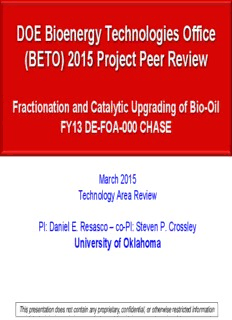
Fractionation and Catalytic Upgrading of Bio-Oil PDF
Preview Fractionation and Catalytic Upgrading of Bio-Oil
DOE Bioenergy Technologies Office (BETO) 2015 Project Peer Review Fractionation and Catalytic Upgrading of Bio-Oil FY13 DE-FOA-000 CHASE March 2015 Technology Area Review PI: Daniel E. Resasco – co-PI: Steven P. Crossley University of Oklahoma This presentation does not contain any proprietary, confidential, or otherwise restricted information Goal Statement • Current technologies: • This project: – low C-retention in – effective fractionation, fuel range combined with – high H consumption. – catalytic upgrading for • C-C bond formation in liquid and vapor • Hydrodeoxygenation phases • Experimental results allow – life-cycle analysis (LCA) and – techno-economic analysis (TEA) back fed to the experimentalists to refine selection of catalyst and process operations • ultimate objective is maximizing C efficiency at minimum H utilization. 2 Quad Chart Overview Timeline Partners Barriers • October, 2013 o OU 50 % Tt-F. Deconstruction of • October, 2016 o INL 25 % Biomass to Form Bio-Oil • 50 % Complete o U. Wisconsin 12.5 % Intermediates o U. Pittsburgh 12.5 % Tt-I. Catalytic Upgrading of Gaseous Intermediates to Budget Fuels and Chemicals Total FY 13 FY 14 Costs Total Planned Costs Costs Funding (FY 15- Tt-J. Catalytic Upgrading of FY 10 Project End Bio-Oil Intermediates to –FY 12 Date Fuels and Chemicals DOE Funded N/A N/A 329,973 1,563,936 Tt-O. Separations Efficiency Project Cost Tt-S. Petroleum Refinery Share N/A N/A 155,420 562,089 (Comp.)* Integration of Bio-Oil Intermediates 3 1 - Project Overview • The team consists of five groups with specific expertise in complementary areas: – Pyrolysis and thermal treatment of biomass – Catalysis in liquid and vapor phases – Separations of multicomponent mixtures (supercritical) Life-cycle analysis - Techno-economic analysis • Collaborative work, permanent contact, and positive feedback among the groups Fractionation Catalysis Clean streams TEA LCA 4 1 - Project Overview Interconnections of knowledge and samples among the various groups of the team 5 2 – Approach (Technical) • Thermal fractionation: – moderate temperatures and times deconstruction of most reactive parts mostly small oxygenates – Higher temperatures and faster heating rates mostly phenolic compounds • Catalytic upgrading: Specific catalyst formulations maximize C retention in liquid phase and minimize catalyst deactivation • Separation: Refining of the different fractions by supercritical extraction and selective adsorption further divides the primary fractions in purer streams • LCA and TEA: Analysis LCA and TEA helps continuous improvement and feedback • Potential challenges are the severely deactivating conditions imposed by the compounds involved in the streams towards the catalysts as well as the complex mixtures that make fractionation complicated. 6 2 – Approach (Management) • The outcome of this project will be a series of possible process strategies to produce stabilized liquid projects that could be inserted in a conventional oil refinery. • The most important challenge is related to process economics • The current goal is to find thermal fractionation processes, catalysts and catalytic reactors, as well as separation processes that minimize the cost and environmental impacts, maximizing the liquid yield • The senior personnel of the different parts of the project are responsible of planning, organizing, controlling resources, and procedures to accomplish the established goal 7 3 – Technical Accomplishments Objective A. Thermal Fractionation Done in multi-stages, with residual solid from each stage becoming the feed of next stage. In the last one, the solid is fast pyrolyzed. The current ° multi-stage system contains two torrefaction stages carried out at 270 C ° ° (20 min) and 360 C (5 min) and the final pyrolysis stage at 500 C (1 min) Mass balance measured in each of the stages 8 Comparison of stage 1 & stage 2 liquid compositions n o 6 ti c a f 5 e r Stage 1 Stage 2 r tod 4 f e ot /µL njec 3 ond i rbui 2 aq cli f 1 o s e ol 0 m Acetic acid Acetol Light Furans Furfurals Pyrans Alkyl Anhydrous Methoxy µ oxygenates Phenols Sugars Phenols Objective B. Supercritical fluid extraction of thermal fractions. This milestone intends to examine different critical fluids for extraction of torrefaction bio-oils. The fluids examined so far included carbon dioxide (CO ), propane (C H ), dimethylether (DME), and 2 3 8 tetrahydrofuran (THF). From these experiments the more significant results indicate that two ethers (DME and THF) were not effective as extraction solvents since they formed 1 phase with the bio-oils. Propane did form 2 phases, but had low extraction efficiencies. With the current result it can be partially concluded that CO appears to be 2 the most promising critical fluid for extraction. 9 Objective C. Design of novel catalysts . Synthesis and characterization of different material with catalytic properties allow us to understand the relationship between synthesis and properties of catalytic materials. This section is dedicated towards the synthesis, and characterization of different materials with potentially good catalytic performance. C. 1 Metal catalysts C.2 Oxide catalysts No Catalysts Preparation method Catalyst BET Surface area (m2/g) 1 1 wt % Pt/SiO (15 g) IWI TiO P25 60 2 2 TiO Anatase 165 2 0.1,1 wt % Ru/SiO (15 g) IWI/Reduction 2 2 Ce Zr O 137 0.5 0.5 2 3 5,10 wt % Ru/SiO (15 g) IWI/Reduction 2 SiO 145 2 4 1 wt % Pd-Fe/SiO (20 g) IWI 2 Al O 122 2 3 5 2 wt % Pd-Fe/SiO (20 g) IWI 2 C. 3 Zeolite catalysts ! 2 Volume (cm3/g) Area (m /g) Material Total Ext Micropore Mesopore Micropore Pore Surface Parent Zeolite 0.186 0.222 0.035 19.5 355 Mesoporous zeolite 0.165 0.305 0.14 51.63 314.9 Mesoporous zeolite acid 0.189 0.357 0.168 61 361 washed (cid:9) 10
Description: